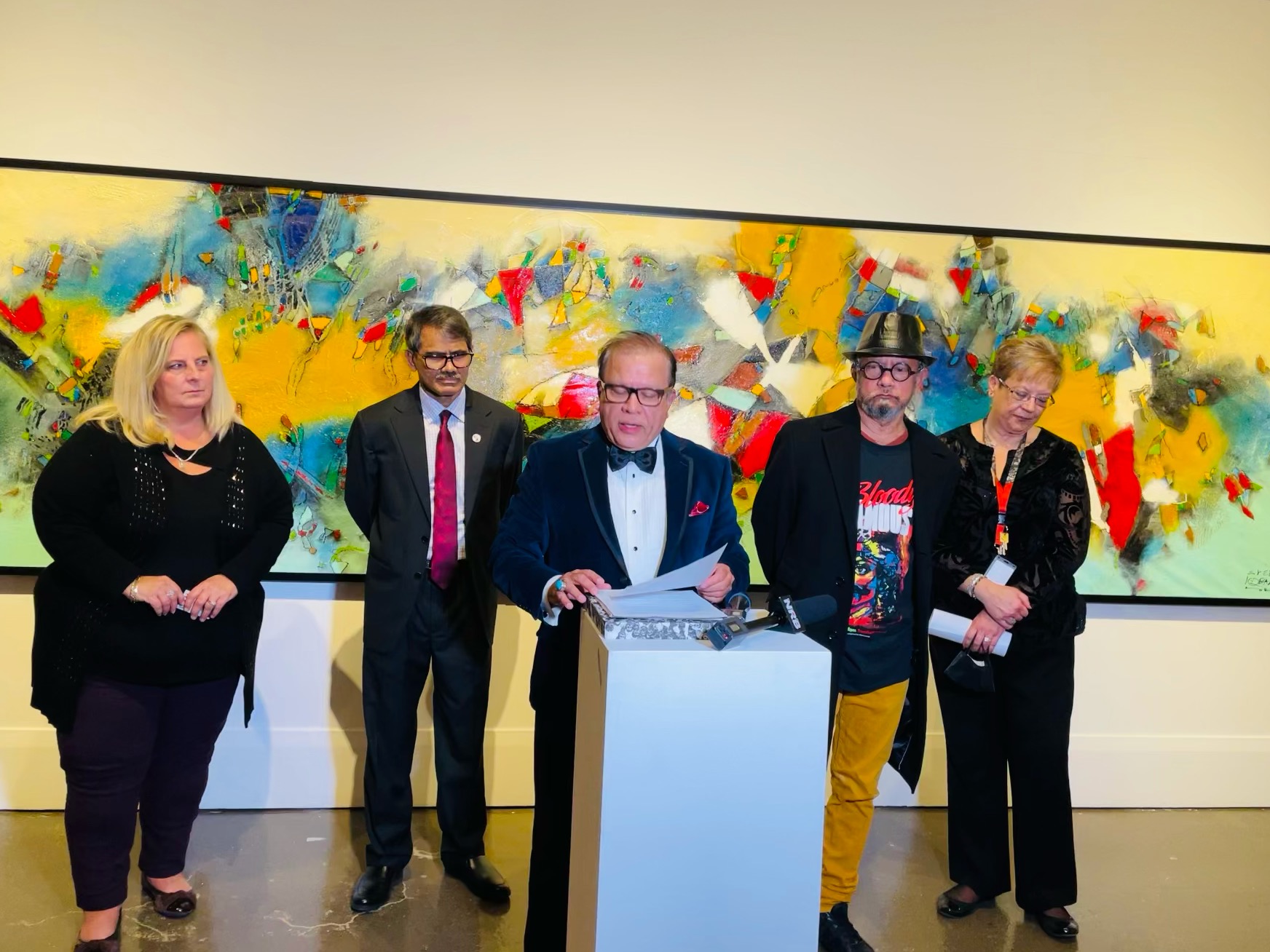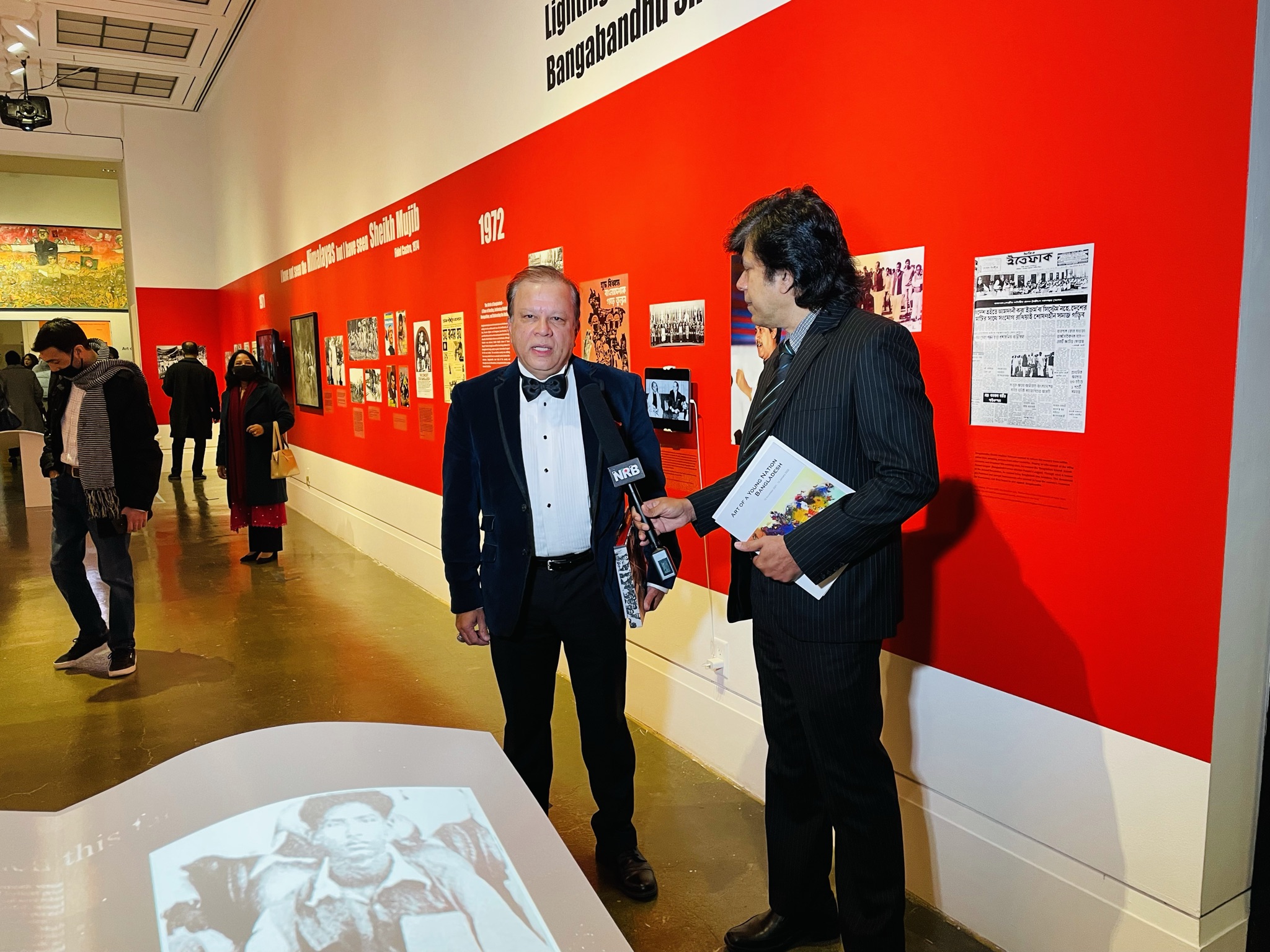
Bismillah Hir Rahman Nir Rahim
Thank you Anna for your very kind and generous introduction.
Good Evening Ladies and Gentlemen and Welcome to Lighting the Fire of Freedom: Bangabandhu Sheikh Mujibur Rahman and Art of a Young Nation: Bangladesh
These two exhibitions celebrate 50 years of independence of Bangladesh and the birth centenary of its founder Sheikh Mujibur Rahman.
I visited Bangladesh pre-independence twice when I was 8 or 9 years old and went around the country from Dhaka to Chittagong which left a lasting impression on me of its distinct art,culture and diversity. I also admired the resilience, creativity, and inclusiveness of its people, and most of all the charismatic personality of their leader Sheikh Mujibur Rahman.
Then almost 30 years later I met artist Syed Iqbal at his exhibition in Toronto, and through him I was introduced to the vibrant art and talented artists of Bangladesh, which led to my visit to Dhaka in 2010 to attend the Asian Art Biennale and the start of my love for abstract art from Bangladesh.
Lighting the Fire of Freedom, in the Robert Freeman Gallery, chronicles the struggle of the people of Bangladesh and their hard-earned freedom under the bold and charismatic leadership of Sheikh Mujibur Rahman who is fondly remembered by the nation as Bangabandhu or “friend of Bengal”. Rare photographs, newspaper clippings and footage has been used to tell an important story of the birth of a new nation. Most of the photographs and other documentation was destroyed after the bloody military coup in 1975 in which Sheikh Mujib and 6 members of his immediate family were assassinated in cold blood, including his 9 year old son. The current prime minister of Bangladesh Sheikh Hasina was living in Brussels at the time with her younger sister, who survived.
Art of a Young Nation: Bangladesh being shown in this room showcases the modern and contemporary arts of Bangladesh through 50 works of 38 outstanding Bangladeshi artists selected from all over the World. In this collection, you can clearly see a strong theme emerging in abstract expressionism that took root in Bangladesh in the late seventies, thanks to their visionary artist and teacher KIBRIA, and quickly flourished across the country, and around the World. His peers and students immersed themselves into this progressive genre to learn, experiment and excel in abstract art and ultimately took it to new heights leading to international recognition and local acceptance.

To understand and appreciate an abstract painting, all you have to do is look into it and form your own impressions based on your imagination.
I am unable to touch upon each and every work in this room, which in itself deserves extended observing and contemplation.
I will however talk about the largest and the smallest painting in the room created by two Bangladeshi Canadian artists – Syed Iqbal and Tajuddin Ahmed who I am proud to say are from the Greater Toronto Area.
The first painting titled “Tears of Nature” behind me by Syed Iqbal (standing to my right) is 18 feet long and created for this exhibition in his studio in the basement of Danforth Furniture on Danforth. [Here, I would like to acknowledge that the large studio space has been generously provided for free to the artist by Mr. Sarwar Rahman owner of the Danforth Furniture, without which you all would not have been able to see this masterpiece. Thank you Sarwar bhai!]
This massive abstract painting in my view is an epitome representation of Bangladesh. It highlights the diverse geographical, cultural and ecological aspects of Bangladesh. One can seethe 700 rivers and tributaries that flow through 24,000 kilometers across the beautiful land, on which the lively hood of many rural Bangladeshis depends through fishing and farming. One can see small boats floating and people working. This painting also highlights the significant impact of climate change on Bangladesh. On the top, due to rapid urbanization and damming of water ways by its large neighbour to the North, the artist is showing the affects of desertification and de-forestation, while at the bottom rising sea levels due to global warming are flooding the coastal areas.
This ladies and gentlemen is a compelling piece of art. The consequences of climate change are huge for this young nation of 167 million and other small island nations of the World. We must do our part to limit global temperature rise to within 1.5C or face catastrophic consequences.
Dr. Deepali Dewan Senior Curator of the Royal Ontario Museum in Toronto has written a compelling essay for the exhibition catalogue titled ‘In the Spirit of Movement” on Syed Iqbal’s art and identifies him as – and I quote “a significant part of a movement of diasporic artists forging new paths that have only now been recognized as historically significant and distinct to the histories of modernism to date”.
The second painting is Untitled work on paper by Tajuddin Ahmed (standing to my left) and is 6×6 inches in size and is one of over 1000 paintings the artist created during the Covid lock-down.His style of painting can be loosely classified as aerial abstractionism, as he presents a bird’s eye view of his surroundings, whether they are in Bangladeshi or in Canada. As an abstractionist, colour and form take center stage in his work. His geospatial thinking combined with ingenious composition and application of colour gives his work an exceptional tonal quality and appeal.
Both Iqbal and Tajuddin have two other large canvases included in this exhibition and I thank them for sharing their creativity and ingenuity with us.

Syed Iqbal’s large painting titled “Father give me a new nation” is 12 feet long and was made on my request for this exhibition. It brilliantly captures the sacrifices made by Bangabandhu and the people of Bangladesh to secure their freedom. By some accounts up to 3 million civilians were killed and 200-400,000 women were raped during the civil war. Iqbal has created a Guernica – a highly moving and powerful anti-war painting.
Lets give a big hand to both of these artists.
I will now point your attention towards these black drapes like installation titled “Shadows of memory” by artist Bipasha Hayat who now divides her time between New York and Dhaka. Her hand-written stories and tales on fine Dhaka Muslin, which was one of the finest produced cloth in the World some 300 years ago. It was said that the cloth was so fine that a whole sari could pass through a ring or fit into a matchbox.
The Stilettoes made from steel blades by Dhaka based artist Tayeba Begum Lipi speaks to the violence facing women in Bangladesh.
The Steel Boots by Dhaka based artist Mahbubur Rahman comment on the role of army in the region and several military coups that have taken place, one most recent being in the neighbouring Mayanmar.
I will conclude by saying that as one of the youngest and most resilient nations in the World, Bangladesh has endured two struggles for independence, genocide, military coups and dictatorships, and several natural and industrial disasters, and most recently the Rohingya refugee crisis caused by the neighboring state of Myanmar. In spite of this, the country has achieved self-sufficiency and economic growth led by its hard-working people, innovative means of micro-financing and a vibrant textile and garments industry. In 2021, Bangladesh’s GDP per capita surpassed that of India and as a whole was close to that of Malaysia and Singapore.
Bangladesh is on its way to becoming an Asian Tiger and its vibrant artsis finding a place on the World stage.
I would like to thank my wife Shehla for tolerating my art obsessions, Anna for believing in my vision for this exhibition, staff of Art Gallery of Missisauga, my co-curator Ruxmini Chaudhary and Nadia and Rajeeb Samdani of the Samdani Art Foundation for their unwavering support and Pinto Khan of the Edge Foundation for loaning and transporting key works from Dhaka, Shahidul Minto of NRB TV, Sarwar Rahman of Danforth Furniture for letting Syed Iqbal maintain his studio in the basement and last but not the least Syed Iqbal for tirelessly working day and night to create his masterpieces.
